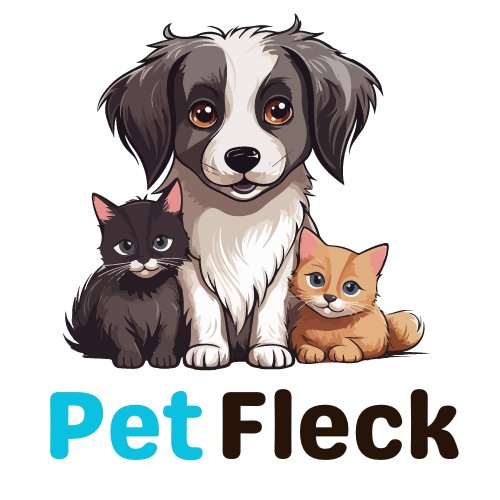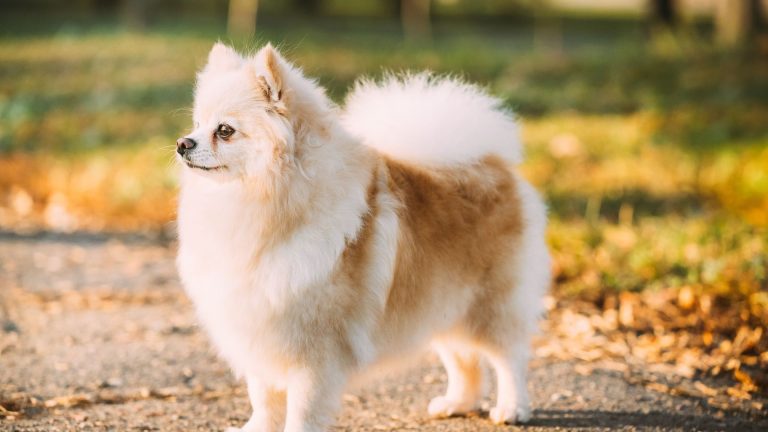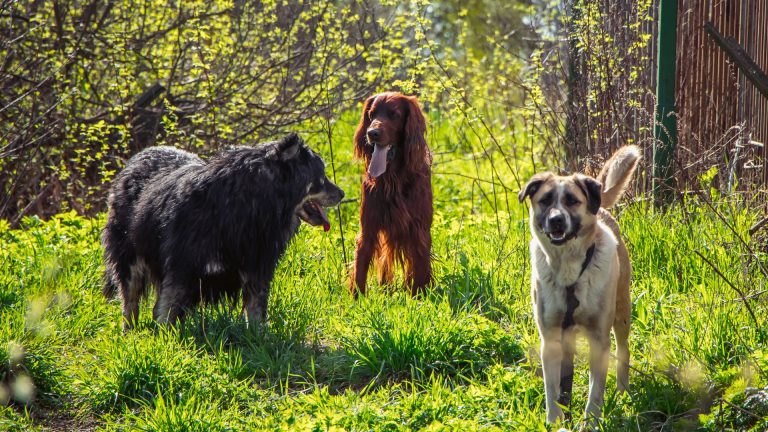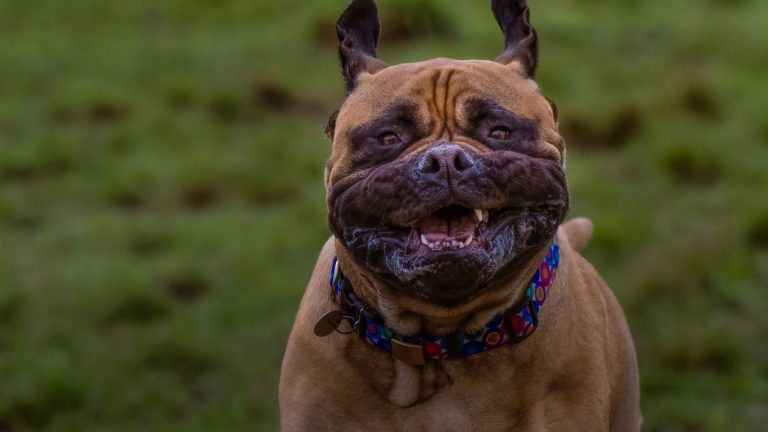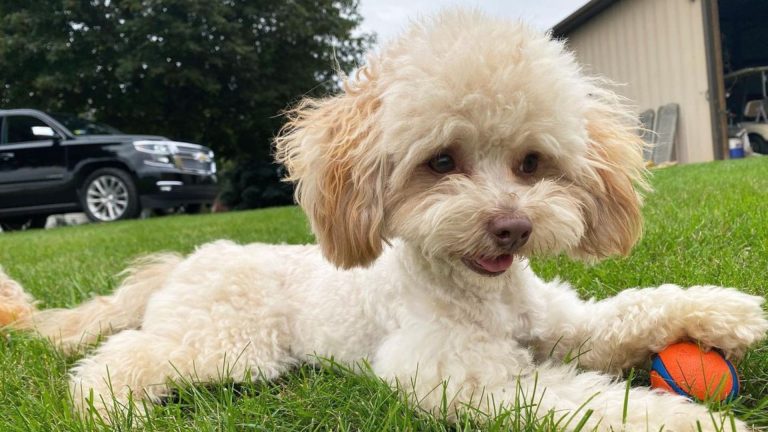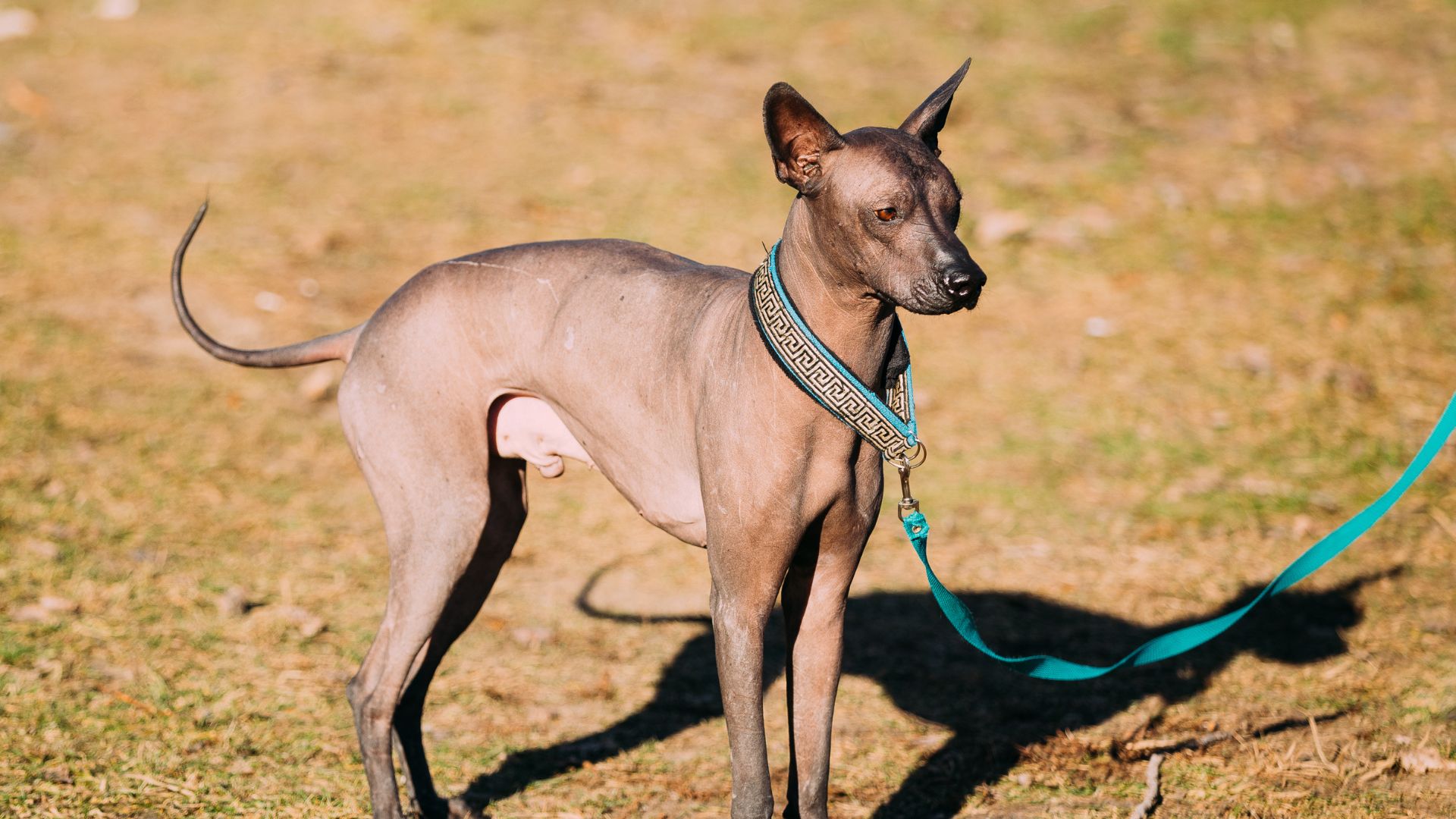
Contents
Skinny dog breeds are known for their lean and elegant physiques. These breeds often have sleek, athletic bodies, making them fast and agile. They can be great companions for active individuals and families. Popular skinny breeds include Greyhounds, Whippets, and Italian Greyhounds.
Choosing the right dog breed is crucial for a pet owner’s lifestyle. A skinny dog breed might be ideal if you enjoy outdoor activities and have a spacious environment. These breeds usually require regular exercise and specific dietary needs to maintain their health. Understanding their characteristics helps ensure a happy and harmonious relationship between the dog and owner. By selecting a breed that fits your lifestyle, you can provide a loving and supportive home for your new pet.
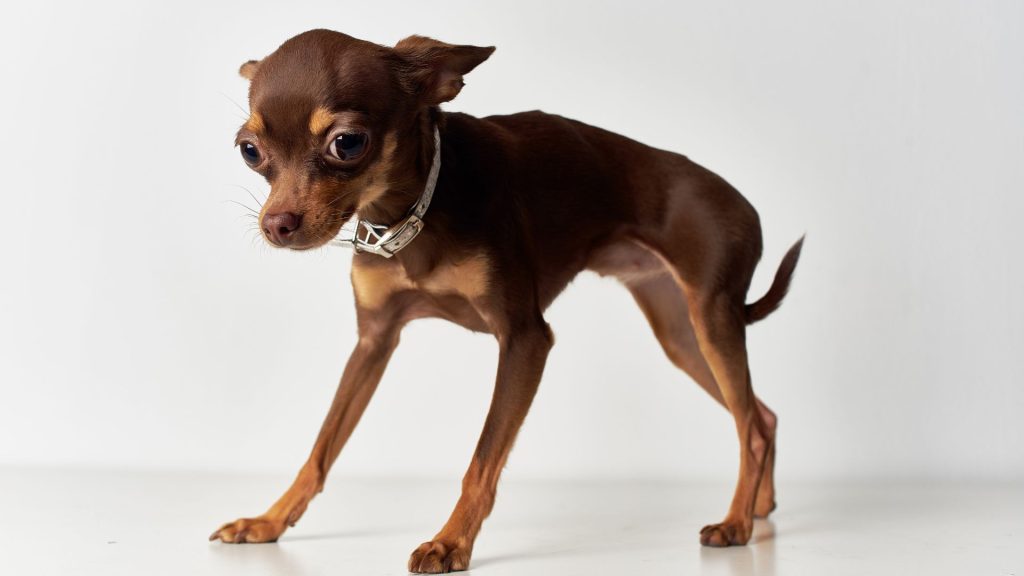
What Defines a Skinny Dog Breed?
Skinny dog breeds are distinguished by their lean, streamlined bodies. These breeds often have low body fat and well-defined muscles. Their sleek appearance is not just for aesthetics; it’s a result of their genetic makeup, designed for agility and speed.
Characteristics of Skinny Dog Breeds
Skinny dog breeds typically have narrow waists, long legs, and deep chests. Their coats can vary, from short and smooth to slightly longer but always fine. Despite their thin appearance, they possess significant muscle strength. Their lightweight frames enable them to run swiftly and with great endurance. Breeds like the Greyhound and Whippet are prime examples, known for their incredible speed and agility.
Common Traits and Features
These breeds often exhibit a calm and gentle temperament. They are usually friendly, affectionate, and bond closely with their owners. Many skinny breeds are sighthounds, relying on their keen vision and speed to hunt. This makes them highly alert and attentive. Their energy levels can vary, but they generally enjoy bursts of intense activity followed by long periods of rest.
Health Benefits and Considerations
Skinny dog breeds tend to have fewer issues with obesity, which can lead to a longer lifespan and fewer joint problems. However, their lean bodies can make them more susceptible to cold weather, so they might need extra warmth during winter. Proper nutrition is crucial, as they require a balanced diet to maintain their muscle mass and overall health. Regular exercise is essential to keep them fit and happy, but it’s equally important to avoid overexertion, especially in extreme temperatures.
Understanding these traits and needs helps in providing the best care for skinny dog breeds, ensuring they lead healthy, fulfilling lives.
Top Skinny Dog Breeds
Here are the top skinny dog breeds known for their lean and elegant physiques. Each breed has unique characteristics and qualities that make them special companions. Let’s explore these breeds and discover what makes them stand out.
Greyhound
The Greyhound is one of the oldest dog breeds, with origins tracing back to ancient Egypt. Historically, they were prized by nobility for their hunting prowess and speed. Greyhounds were depicted in ancient art and literature, symbolizing grace and agility.
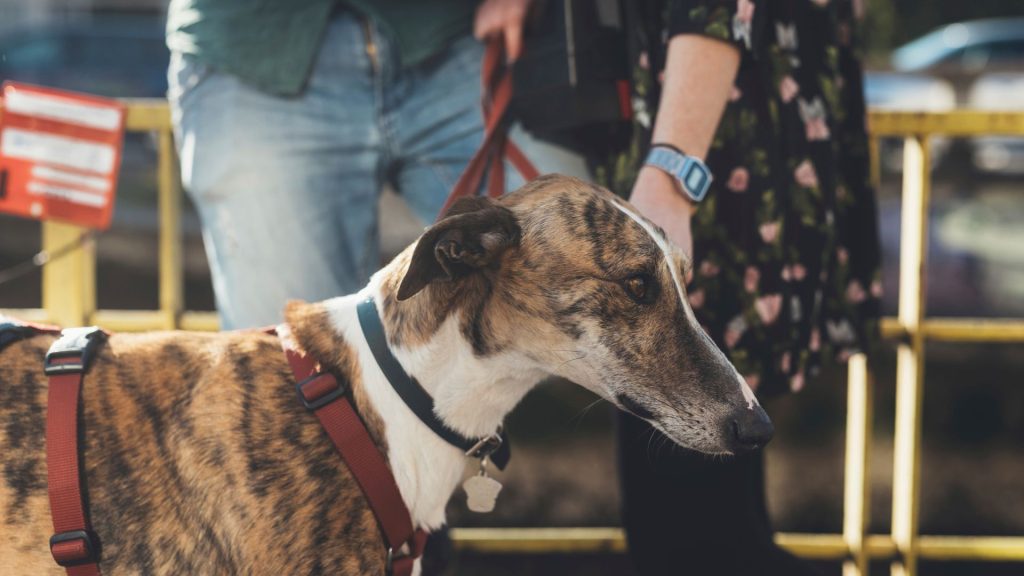
Physical Characteristics
Greyhounds are known for their sleek, aerodynamic bodies. They have a narrow head, long neck, deep chest, and slim waist. Their long legs and muscular build enable them to reach speeds of up to 45 miles per hour. Their coat is short and smooth, coming in various colors such as black, fawn, blue, and brindle.
Temperament and Personality
Greyhounds are gentle and affectionate dogs. They are known for their calm demeanor and tend to be quiet and reserved indoors. Despite their athletic build, they are often referred to as “couch potatoes” due to their love for lounging and relaxing. Greyhounds are friendly with other dogs and generally good with children, making them excellent family pets.
Care and Exercise Needs
Greyhounds require regular exercise to maintain their health and happiness. A daily walk or run in a secure area is essential. They also enjoy playing in open spaces. Due to their thin skin and low body fat, they are sensitive to extreme temperatures, so it’s important to provide them with warmth in cold weather and avoid strenuous activity in the heat.
Their short coat requires minimal grooming, but regular brushing helps keep it in good condition. A balanced diet is crucial to support their high energy levels and lean physique. Regular veterinary check-ups are important to monitor their health and prevent common issues such as dental problems and arthritis.
In summary, Greyhounds are elegant, loving, and low-maintenance dogs that thrive with proper care and attention.
Whippet
The Whippet originated in England during the late 19th century. Bred from Greyhounds and smaller terriers, Whippets were developed for hunting small game and racing. Known as the “poor man’s racehorse,” they gained popularity among miners and laborers who enjoyed racing them for sport.
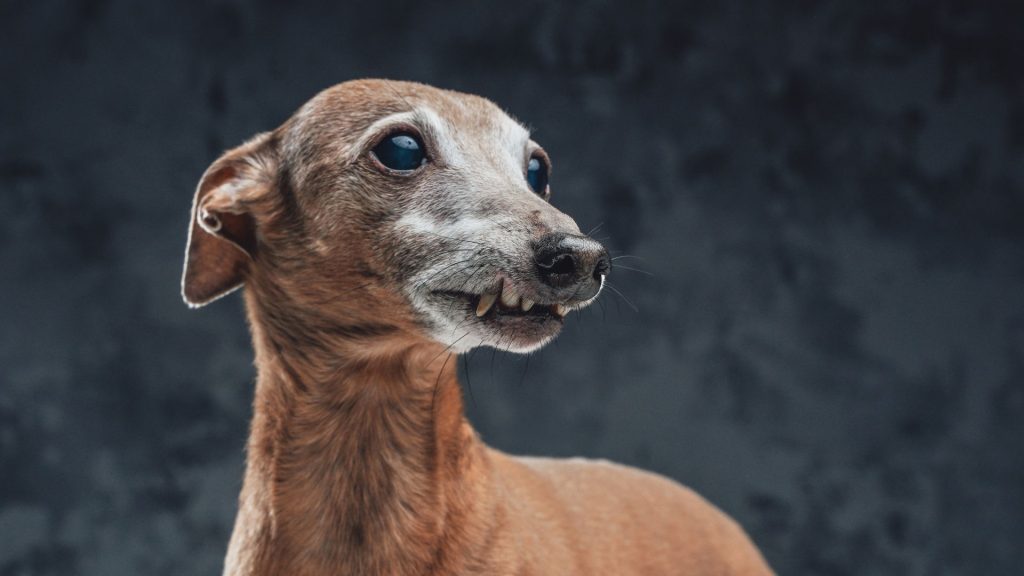
Physical Characteristics
Whippets are medium-sized dogs with a sleek, aerodynamic build. They have a narrow head, long neck, deep chest, and slim waist. Their legs are long and slender, allowing them to reach speeds of up to 35 miles per hour. The Whippet’s coat is short, smooth, and comes in a variety of colors, including black, white, fawn, blue, and brindle.
Temperament and Personality
Whippets are gentle, affectionate, and friendly dogs. They are known for their calm and laid-back nature indoors, making them excellent companions for families and individuals. Whippets are generally good with children and other dogs, though they can be reserved around strangers. Their keen sight and natural hunting instincts make them alert and attentive.
Care and Exercise Needs
Whippets require regular exercise to stay healthy and happy. A daily walk or run in a secure, fenced area is essential. They enjoy sprinting and playing, but also appreciate lounging and relaxing indoors. Due to their thin skin and low body fat, Whippets are sensitive to cold weather and may need extra warmth during colder months.
Grooming needs are minimal, with regular brushing to keep their coat in good condition. A balanced diet is important to support their energy levels and maintain their lean physique. Regular veterinary check-ups are crucial to monitor their health and prevent common issues such as dental problems and joint issues.
In summary, Whippets are elegant, loving, and low-maintenance dogs that thrive with proper care and attention. Their gentle nature and athletic build make them wonderful companions for active families and individuals.
Italian Greyhound
The Italian Greyhound has a rich history dating back over 2,000 years. Believed to have originated in the Mediterranean region, this breed was favored by nobility in Greece and Rome. During the Renaissance, Italian Greyhounds became popular in Italy, where they gained their current name. They were cherished for their elegance and companionship, often depicted in Renaissance art alongside their noble owners.

Physical Characteristics
Italian Greyhounds are small, slender dogs with an elegant and refined appearance. They have a narrow head, long neck, deep chest, and slim, tucked-up abdomen. Their legs are long and delicate, giving them a graceful and agile look. The coat of an Italian Greyhound is short, smooth, and glossy, coming in various colors, including fawn, blue, black, and red. Their eyes are large and expressive, contributing to their charming appearance.
Temperament and Personality
Italian Greyhounds are affectionate, gentle, and intelligent dogs. They form strong bonds with their owners and thrive on human companionship. While they are generally friendly and sociable, they can be shy or reserved around strangers. Italian Greyhounds are known for their playful and lively nature, enjoying games and activities that engage their agility and speed. Despite their energy, they also love to snuggle and spend quiet time with their families.
Care and Exercise Needs
Italian Greyhounds require regular exercise to maintain their physical and mental health. A daily walk, combined with playtime in a secure, fenced area, is essential. They enjoy running and sprinting but are also content with shorter bursts of activity. Due to their thin coat and low body fat, Italian Greyhounds are sensitive to cold weather and may need extra warmth during colder months, such as sweaters or blankets.
Grooming is minimal for this breed, with occasional brushing to keep their coat in good condition. Regular dental care is important, as Italian Greyhounds can be prone to dental issues. A balanced diet tailored to their size and activity level helps maintain their lean physique and overall health. Regular veterinary check-ups are necessary to monitor their well-being and prevent common health issues such as dental disease and joint problems.
In summary, Italian Greyhounds are elegant, loving, and loyal companions. Their gentle nature, combined with their playful and active personality, makes them ideal pets for individuals and families who can provide the care and attention they need.
Saluki
The Saluki, one of the oldest known dog breeds, has a history that spans over 4,000 years. Originating in the Middle East, these dogs were highly valued by ancient civilizations, including the Egyptians, Persians, and Bedouins. They were bred for hunting game in harsh desert environments, prized for their speed, endurance, and keen eyesight. Salukis were often depicted in ancient art and hieroglyphs, symbolizing nobility and grace.

Physical Characteristics
Salukis are elegant and athletic dogs with a distinctive appearance. They have a slim, aerodynamic body, long legs, and a deep chest that enables them to run at high speeds. Their coat can be either smooth or feathered, with long, silky hair on the ears, tail, and legs. Salukis come in a variety of colors, including white, cream, fawn, gold, red, and black and tan. Their eyes are large and expressive, adding to their noble and graceful look.
Temperament and Personality
Salukis are gentle, independent, and loyal dogs. They tend to form strong bonds with their owners but can be reserved and aloof around strangers. Despite their dignified demeanor, they have a playful side and enjoy activities that engage their agility and speed. Salukis are known for their quiet and calm nature indoors, often preferring to lounge and relax. They are generally good with children and other pets but may have a strong prey drive due to their hunting heritage.
Care and Exercise Needs
Salukis require regular exercise to maintain their physical and mental health. A daily walk or run, along with playtime in a secure, fenced area, is essential to keep them fit and happy. They excel in activities like lure coursing, which mimic their natural hunting instincts. Due to their thin coat and low body fat, Salukis are sensitive to cold weather and may need additional warmth in cooler climates.
Grooming needs for Salukis are minimal. Regular brushing helps keep their coat clean and free of tangles, especially for feathered Salukis. Attention to dental care is important, as they can be prone to dental issues. A balanced diet that supports their activity level and lean physique is crucial for their overall health. Regular veterinary check-ups help monitor their well-being and address any health concerns.
In summary, Salukis are elegant, loyal, and graceful companions. Their independent yet affectionate nature, combined with their athleticism, makes them ideal pets for active individuals or families who can provide the care and exercise they need.
Basenji
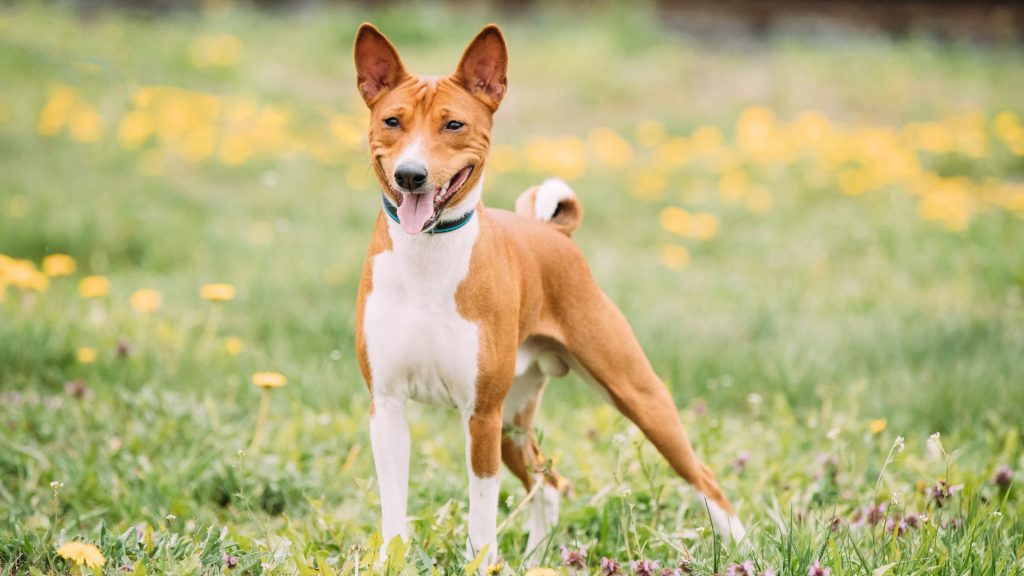
The Basenji is an ancient breed that originated in Central Africa, primarily in the Congo region. Known as the “barkless dog,” Basenjis were used by local tribes for hunting small game and tracking. Their unique ability to produce a yodel-like sound, rather than barking, made them stand out. The breed was first introduced to the Western world in the 19th century and quickly gained popularity for its distinctive traits and appearance.
Physical Characteristics
Basenjis are small, muscular dogs with a graceful, athletic build. They have a short, sleek coat that comes in various colors, including red, black, brindle, and tricolor, often with white markings. Their expressive eyes are almond-shaped, and they have distinctive, tightly curled tails. One of their most notable features is their upright, pointed ears, which give them an alert and inquisitive look. Basenjis have a fine, supple skin that contributes to their elegant appearance.
Temperament and Personality
Basenjis are intelligent, independent, and energetic dogs. They are known for their curious and playful nature, often getting into mischief due to their high energy levels and clever minds. Despite their independence, they form strong bonds with their owners and can be quite affectionate. Basenjis are generally good with children and other pets but may exhibit a strong prey drive, given their hunting background. Their quiet demeanor makes them suitable for apartment living, but they do require mental stimulation and physical activity.
Care and Exercise Needs
Basenjis need regular exercise to stay healthy and happy. Daily walks, play sessions, and opportunities to run in a secure, fenced area are essential. They enjoy activities that challenge their intelligence and agility, such as puzzle toys and interactive games. Due to their short coat, grooming needs are minimal, with occasional brushing to remove loose hair. Basenjis are known for their fastidious grooming habits, similar to cats.
These dogs are sensitive to cold weather due to their short coat and may need extra warmth in cooler climates. A balanced diet tailored to their size and activity level is important to maintain their lean physique and overall health. Regular veterinary check-ups help monitor their well-being and prevent common health issues, such as Fanconi syndrome, a genetic disorder affecting the kidneys.
In summary, Basenjis are intelligent, independent, and energetic companions. Their unique traits, combined with their affectionate nature, make them ideal pets for owners who can provide the necessary care, exercise, and mental stimulation.
Pharaoh Hound
The Pharaoh Hound is an ancient breed with roots tracing back to ancient Egypt, over 5,000 years ago. These dogs were depicted in various Egyptian artifacts, including tomb paintings and sculptures, often accompanying pharaohs and nobility. Despite their ancient Egyptian origins, the modern Pharaoh Hound was developed in Malta, where they were used for hunting rabbits and other small game. The breed’s name reflects its regal and historic connection to ancient Egypt.
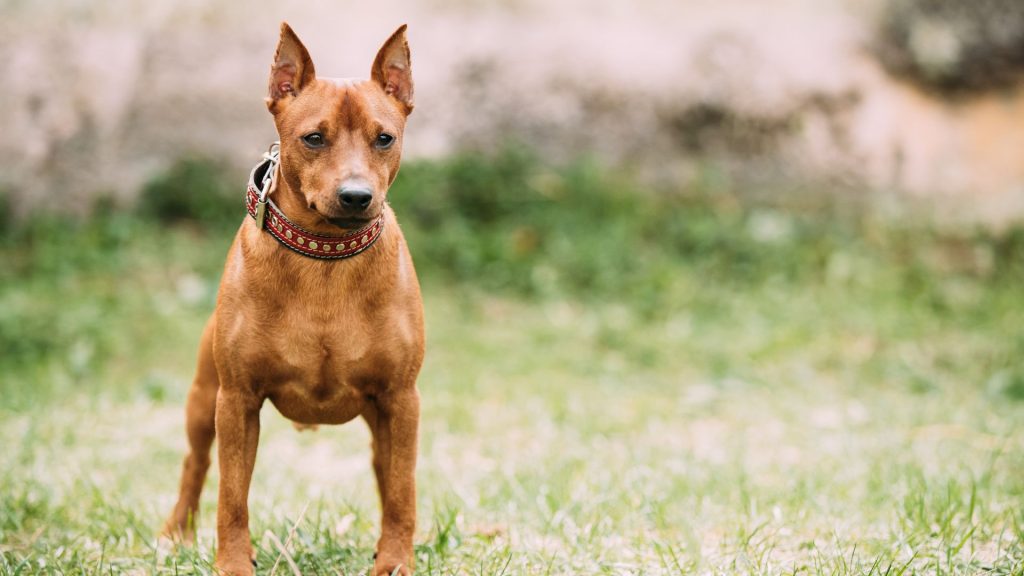
Physical Characteristics
Pharaoh Hounds are medium-sized, graceful dogs with a sleek, athletic build. They have a distinctively noble appearance, characterized by their elongated head, large pointed ears, and amber eyes that give them an alert and intelligent expression. Their coat is short, fine, and comes in shades of tan or rich chestnut. One of their unique features is their ability to blush, with their nose and ears turning a rosy pink when excited or happy.
Temperament and Personality
Pharaoh Hounds are intelligent, friendly, and affectionate dogs. They form strong bonds with their families and are known for their playful and energetic nature. While they are generally good with children and other dogs, they can be reserved around strangers. Their keen sense of sight and strong prey drive make them excellent hunters, but this also means they require a secure environment to prevent them from chasing after small animals.
Care and Exercise Needs
Pharaoh Hounds need regular exercise to stay healthy and happy. A daily walk, combined with playtime in a secure, fenced area, is essential. They excel in activities that challenge their agility and speed, such as lure coursing and agility training. Due to their short coat, grooming needs are minimal, requiring only occasional brushing to keep their coat in good condition. Regular dental care is important to prevent dental issues.
Pharaoh Hounds are sensitive to cold weather and may need additional warmth in cooler climates. A balanced diet tailored to their size and activity level is crucial to maintain their lean physique and overall health. Regular veterinary check-ups help monitor their well-being and prevent common health issues such as hip dysplasia and hypothyroidism.
In summary, Pharaoh Hounds are elegant, intelligent, and affectionate companions. Their playful and energetic nature, combined with their regal appearance, makes them ideal pets for active families and individuals who can provide the necessary care and exercise.
Sloughi
The Sloughi, also known as the Arabian Greyhound, is an ancient breed that originated in North Africa, particularly in Morocco, Algeria, Tunisia, and Libya. This breed has been cherished by the Berber people for centuries, used for hunting game in the harsh desert environments. The Sloughi is one of the few breeds that has maintained its pure lineage, largely due to its isolation in remote regions. Known for its speed, endurance, and keen eyesight, the Sloughi has been a valuable companion for hunting and guarding.
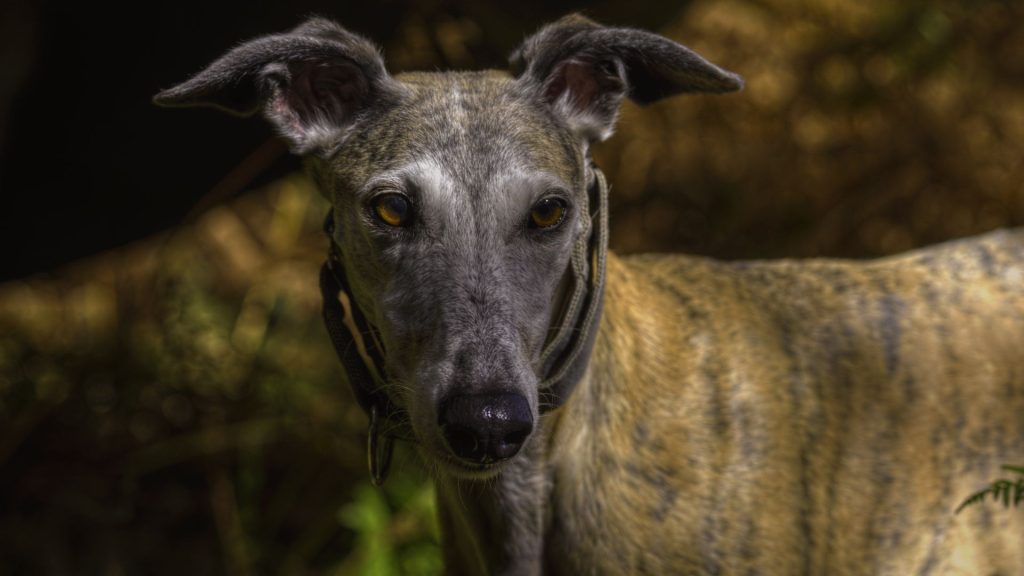
Physical Characteristics
The Sloughi is a medium to large-sized dog with a slim, athletic build that is well-suited for speed and agility. They have a long, narrow head, large expressive eyes, and a graceful, streamlined body. Their coat is short, smooth, and comes in various shades of fawn, ranging from light to dark, sometimes with black markings or a black mask. The Sloughi’s ears are set high and are often folded over, giving them a distinctive and elegant appearance.
Temperament and Personality
Sloughis are known for their loyal, gentle, and reserved nature. They form strong bonds with their families and are typically very affectionate with their owners. While they can be aloof with strangers, they are not aggressive. Sloughis are generally good with other dogs, but their strong prey drive means they may chase smaller animals. They are intelligent and sensitive, requiring a gentle approach to training and handling.
Care and Exercise Needs
Sloughis require regular exercise to maintain their physical and mental health. They enjoy running and playing in secure, fenced areas and benefit from daily walks or runs. Their high energy levels and natural hunting instincts make them excellent participants in activities like lure coursing. Due to their short coat, grooming is minimal, with occasional brushing to remove loose hair and keep their coat in good condition.
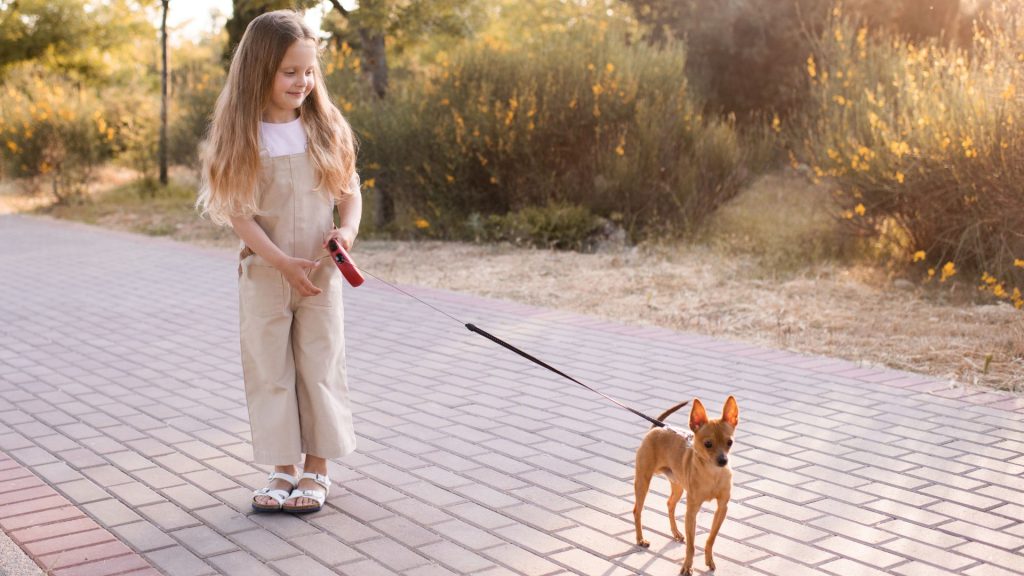
The Sloughi is sensitive to cold weather and may need additional warmth during colder months. A balanced diet that meets their nutritional needs is essential to support their lean physique and active lifestyle. Regular veterinary check-ups are important to monitor their health and address any potential issues, such as hip dysplasia or progressive retinal atrophy, conditions to which they may be prone.
In summary, Sloughis are loyal, gentle, and elegant companions. Their combination of speed, endurance, and affectionate nature makes them ideal pets for active families and individuals who can provide the care, exercise, and attention they need to thrive.
How to Care for Skinny Dog Breeds
Proper nutrition is essential for skinny dog breeds. These dogs have high metabolisms and need a balanced diet rich in proteins and healthy fats. Choose high-quality dog food with meat as the first ingredient and avoid fillers. Ensure they receive enough calories to support their energy levels. Consult a veterinarian for feeding schedules and portion sizes.
Exercise Requirements
Regular exercise is crucial for skinny dog breeds. Daily walks and opportunities to run in secure areas are ideal. Engage them in activities like agility training and fetch to keep them stimulated. Adjust exercise routines based on the weather, as these breeds can be sensitive to temperature extremes.
Grooming Needs
Grooming is minimal for most skinny dog breeds. Their short, smooth coats require occasional brushing to remove loose hair. Regularly check and clean their ears and brush their teeth several times a week. Bathe them as needed and trim their nails regularly.
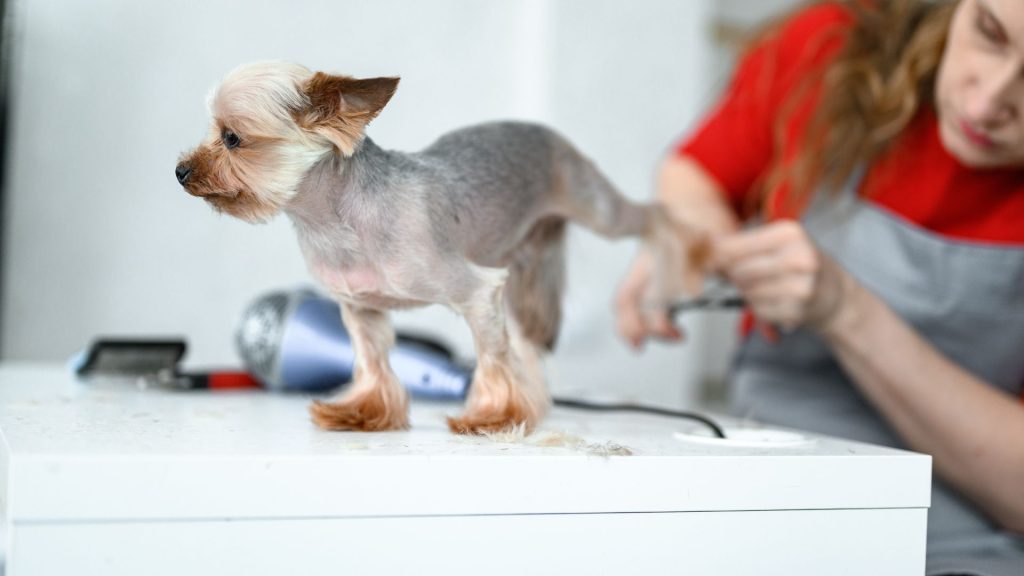
Health Considerations
Regular veterinary check-ups are important for monitoring the health of skinny dog breeds. Common issues include joint problems and dental diseases. These dogs are sensitive to temperature changes, so provide extra warmth in cold weather and shade in hot weather. Maintain a consistent exercise routine and balanced diet to ensure their well-being.
By addressing these needs, you can ensure your skinny dog breed remains healthy, happy, and active.
Conclusion
Skinny dog breeds offer numerous benefits, including their elegant appearance, gentle temperament, and athletic abilities. These breeds are often low-maintenance in terms of grooming and are known for their loyalty and affection. Their high energy levels and intelligence make them excellent companions for active individuals and families.
Considering adopting a skinny dog breed can bring a loving, energetic, and graceful companion into your life. With proper care, nutrition, and exercise, these dogs thrive and become loyal, cherished members of the family. Embrace the unique qualities of skinny dog breeds and enjoy the rewarding experience of having one as a pet.

Hello, I’m Donna Carter, the founder and writer behind PetFleck.com. My journey with dogs started years ago, and it’s been a passion that has only grown stronger over time. I’ve always been fascinated by the unique behaviors and characteristics of different dog breeds, and this curiosity has led me to dive deep into the world of canine studies.
My love for dogs is the driving force behind everything I do. I’ve dedicated countless hours to researching and understanding the nuances of dog care, training, and breed-specific traits. This dedication helps me create content that is not only informative but also genuinely helpful for fellow dog lovers and owners.
At PetFleck, I combine my extensive knowledge and hands-on experience with my passion for dogs to provide valuable insights and tips. Whether it’s exploring different breeds or offering practical advice on dog care, I aim to share knowledge that makes a real difference in the lives of dogs and their families.
I’m thrilled to share my love for dogs with you through my writing. I hope my articles inspire and inform, helping you to better understand and appreciate the incredible bond we share with our furry friends.
Thank you for visiting PetFleck.com, and I look forward to connecting with you through our shared love of dogs!
